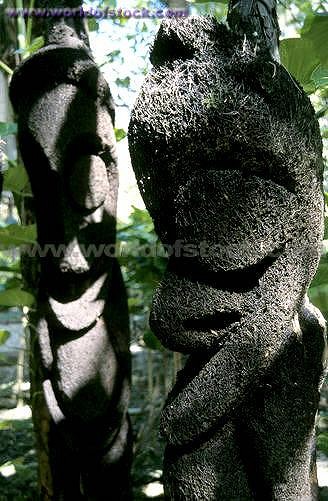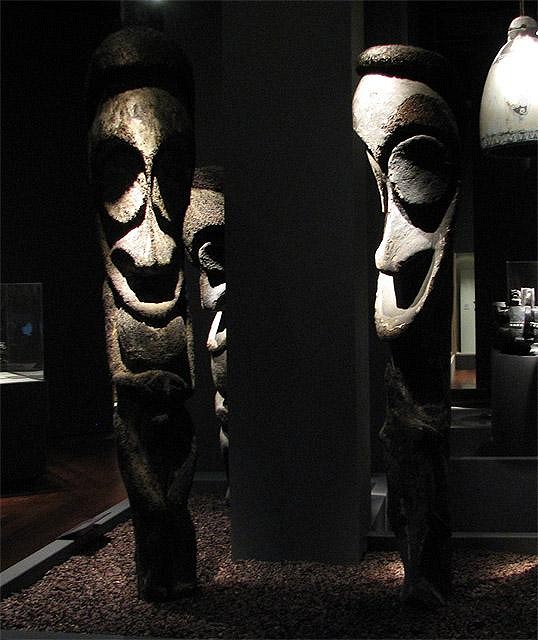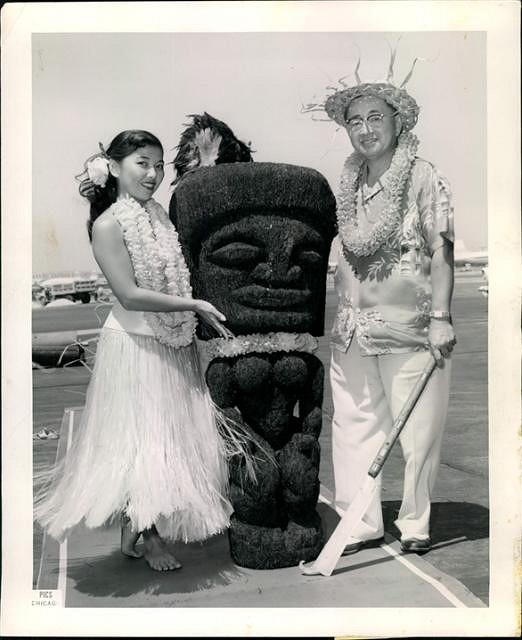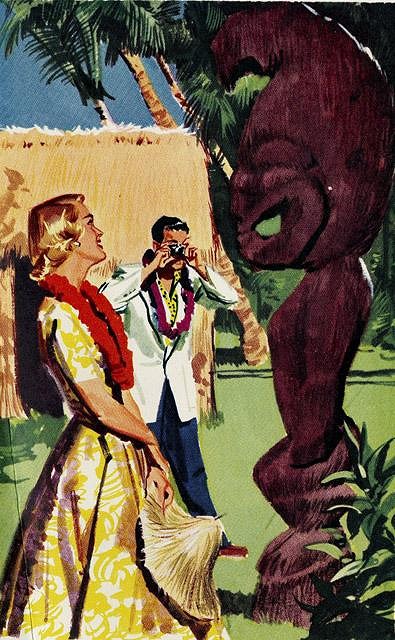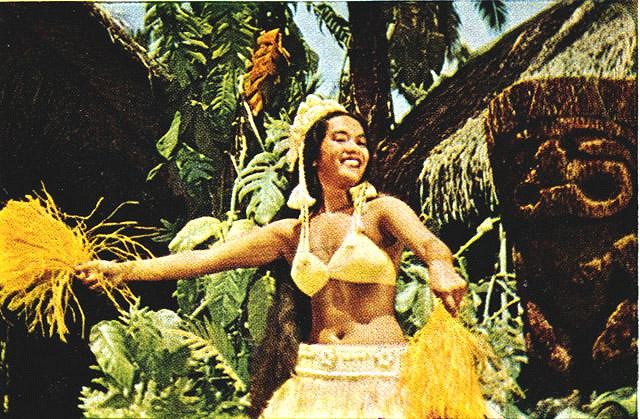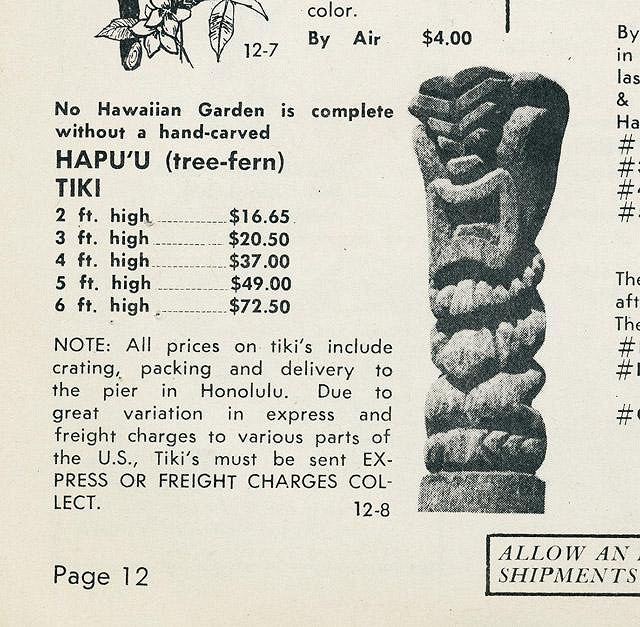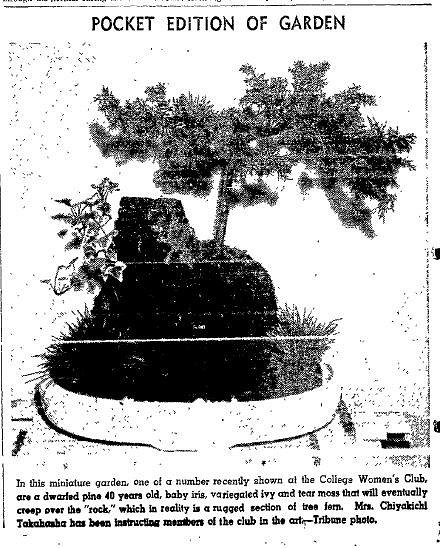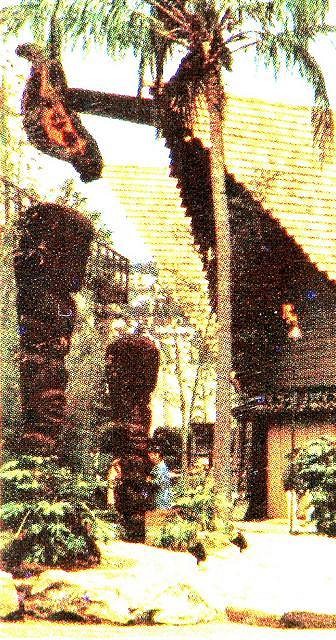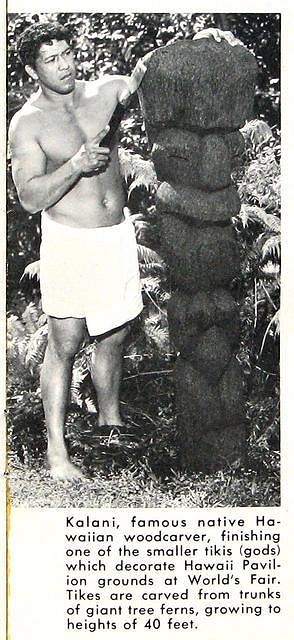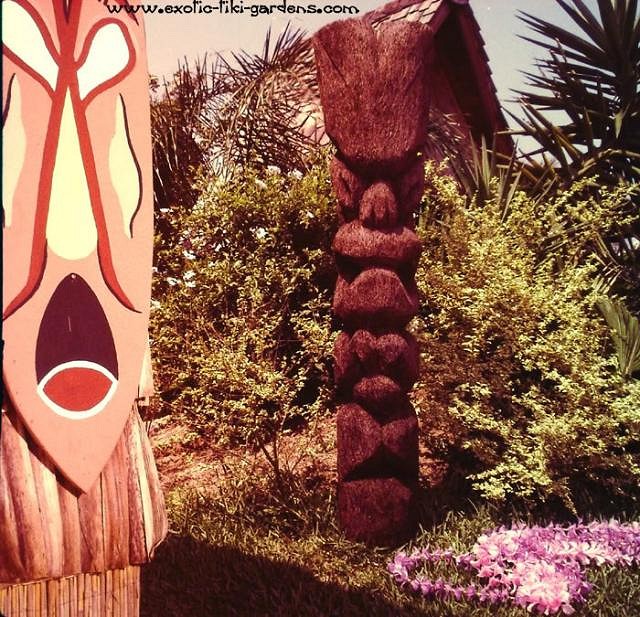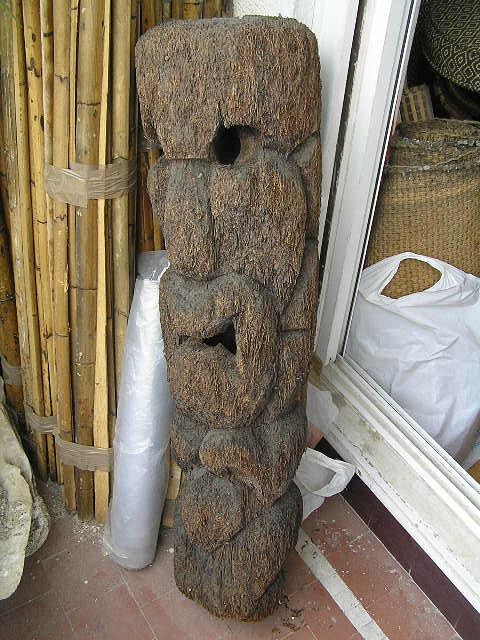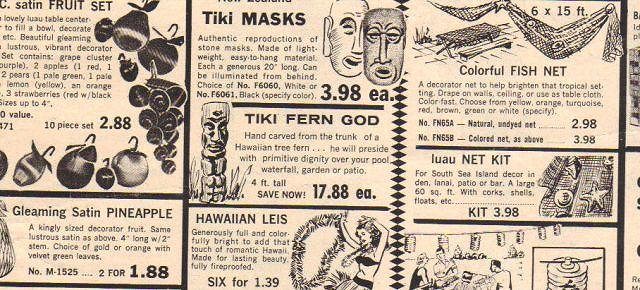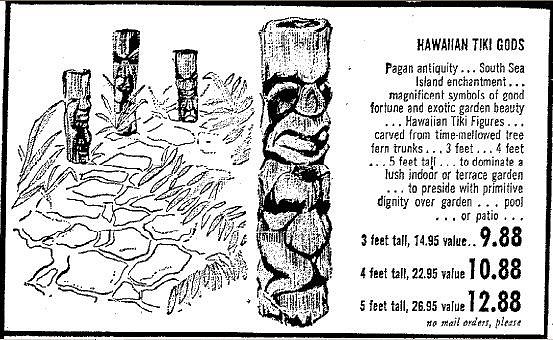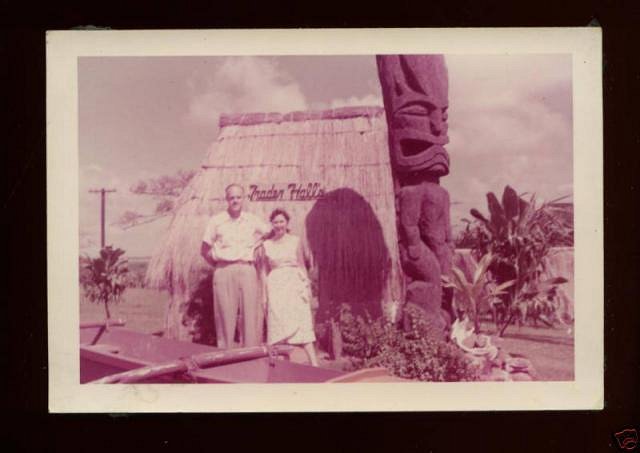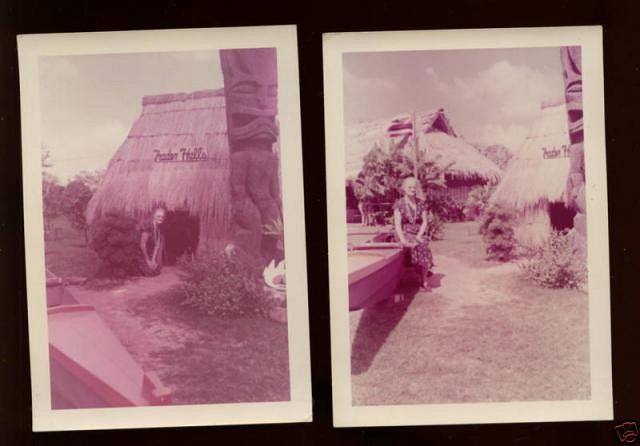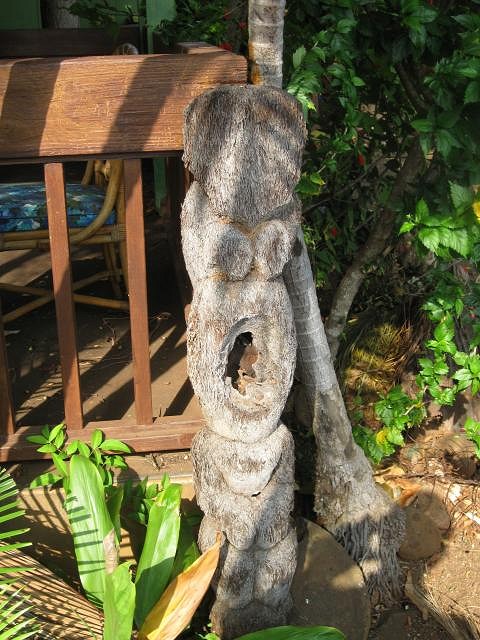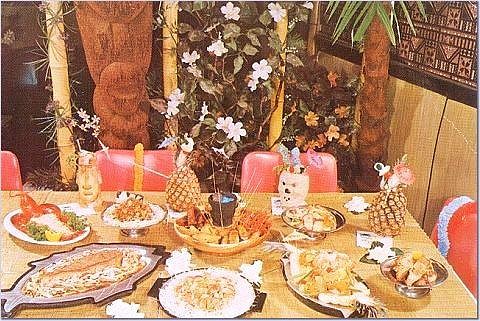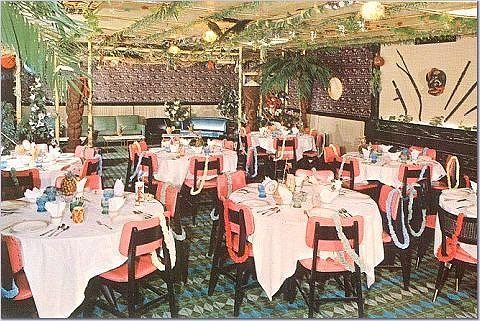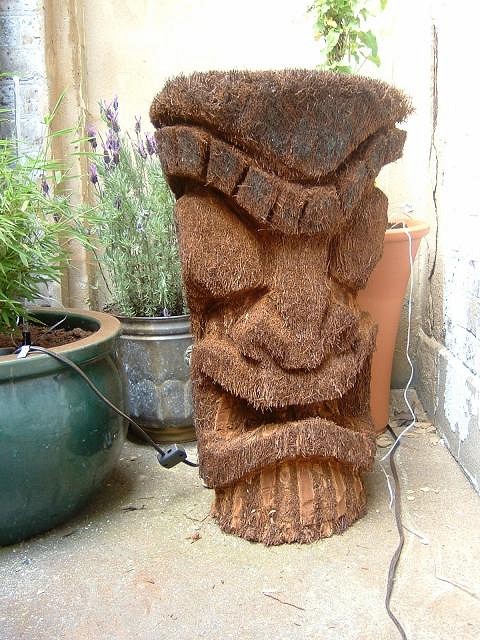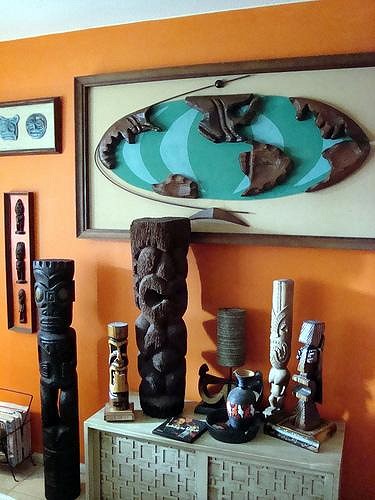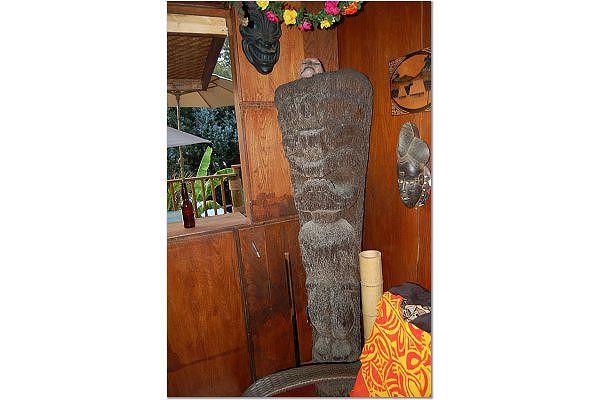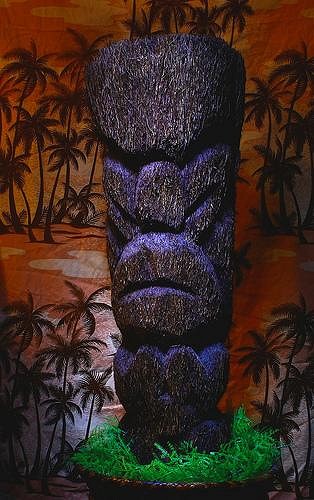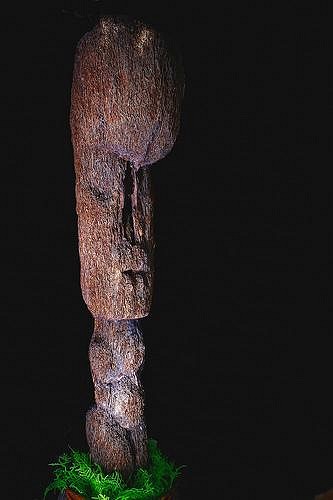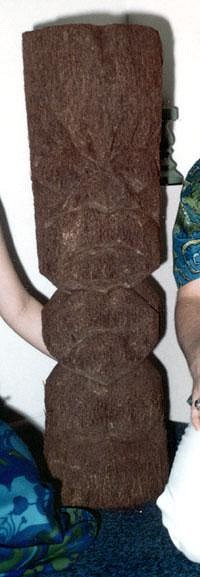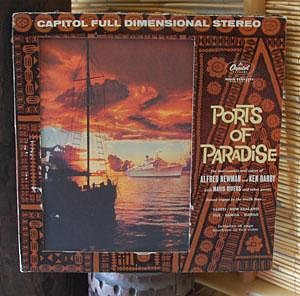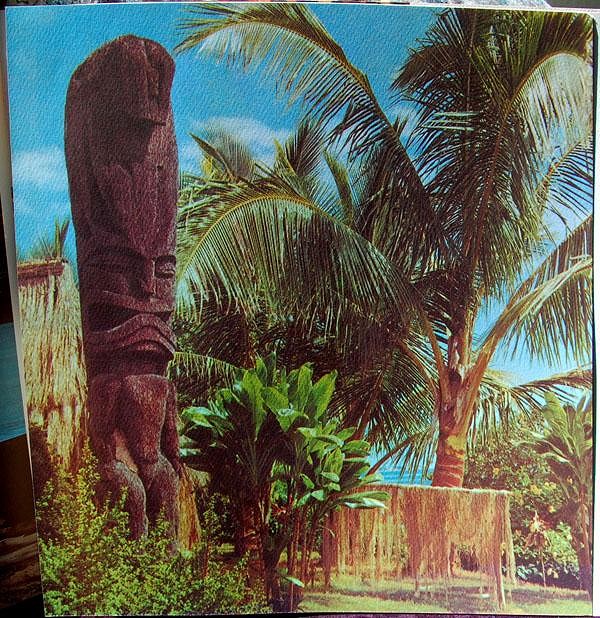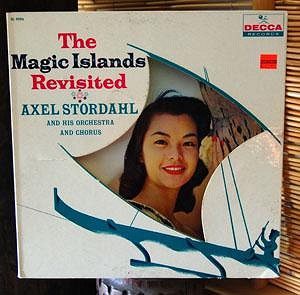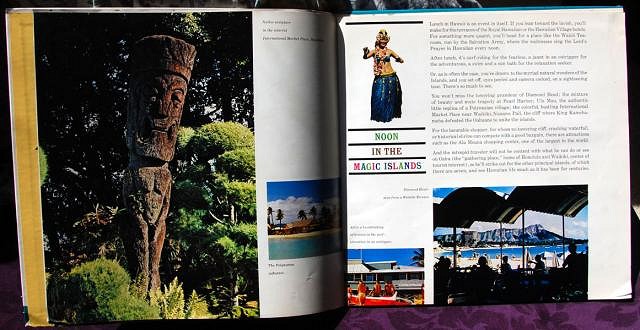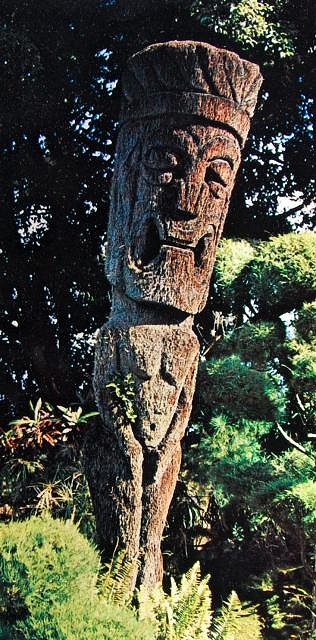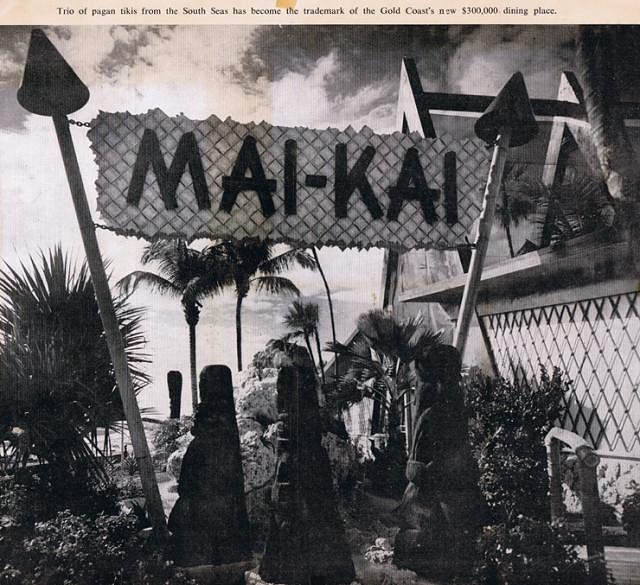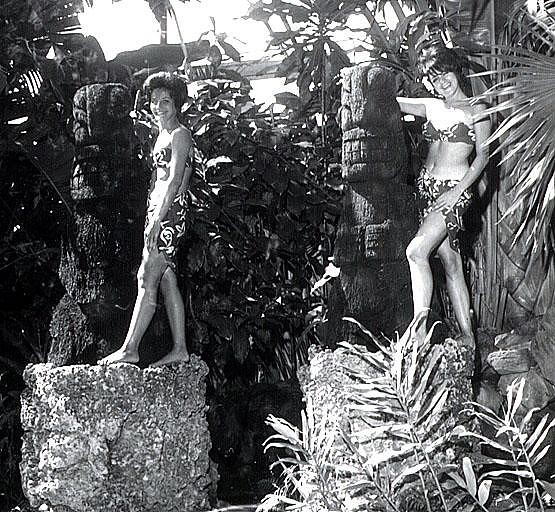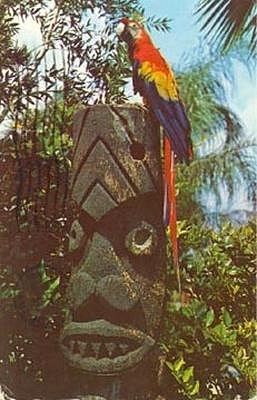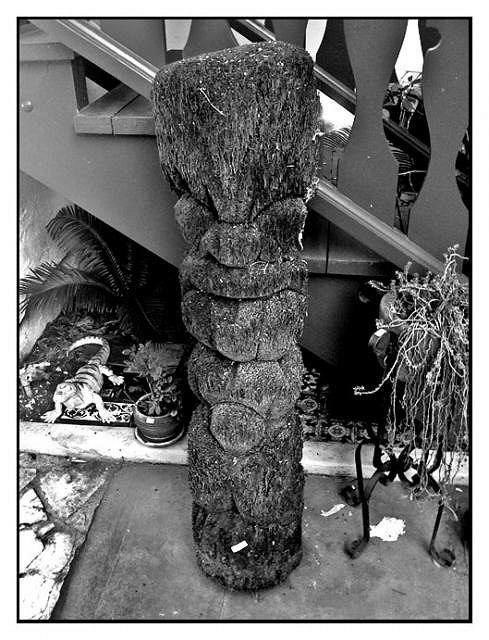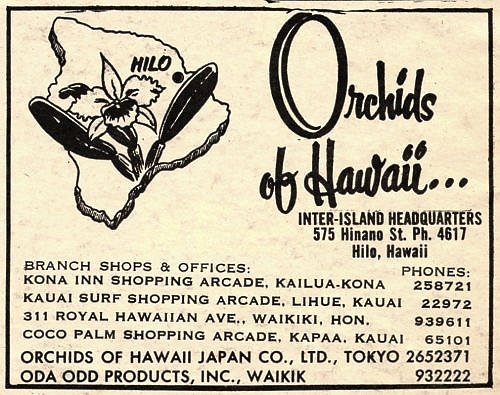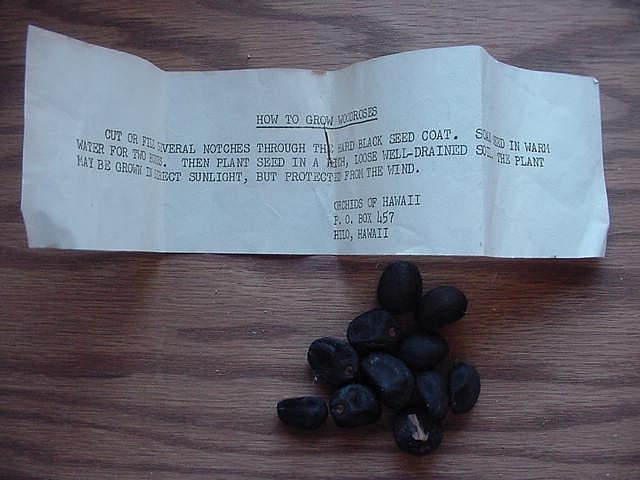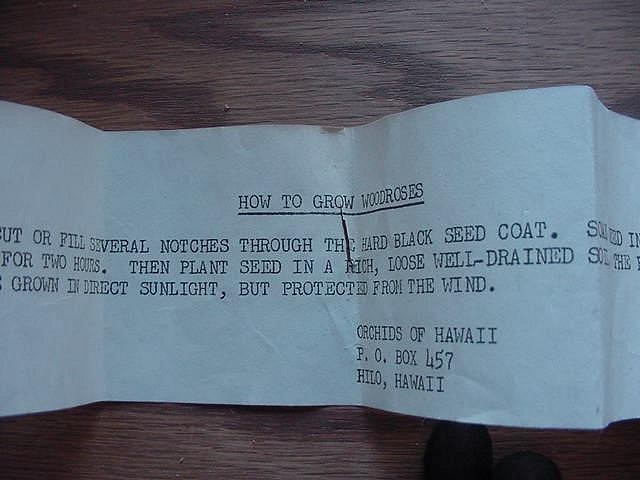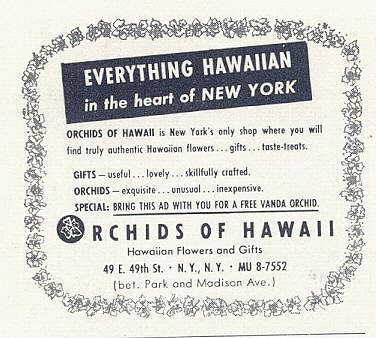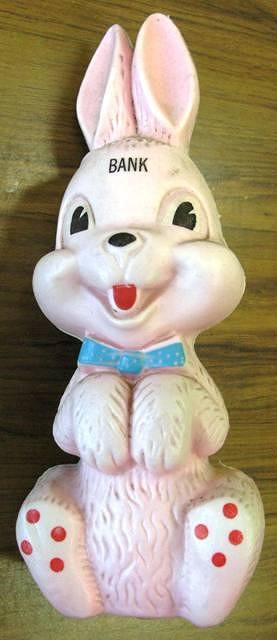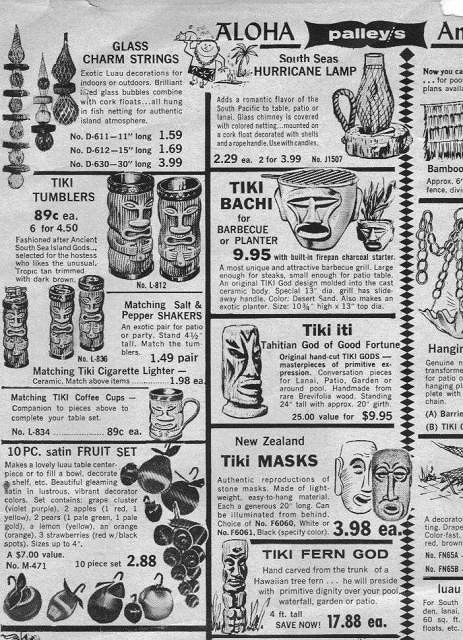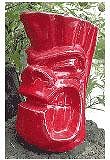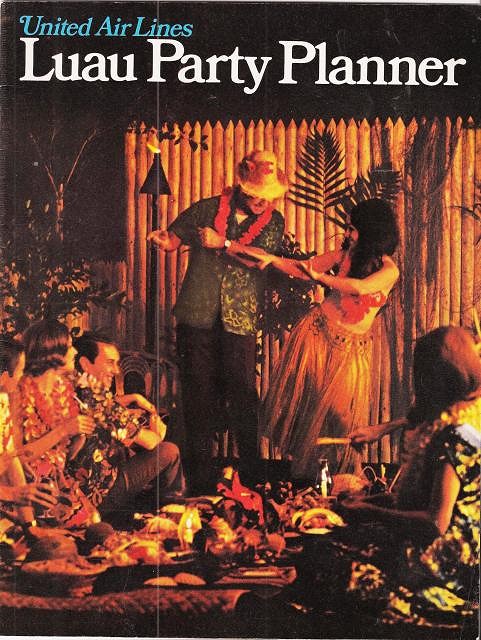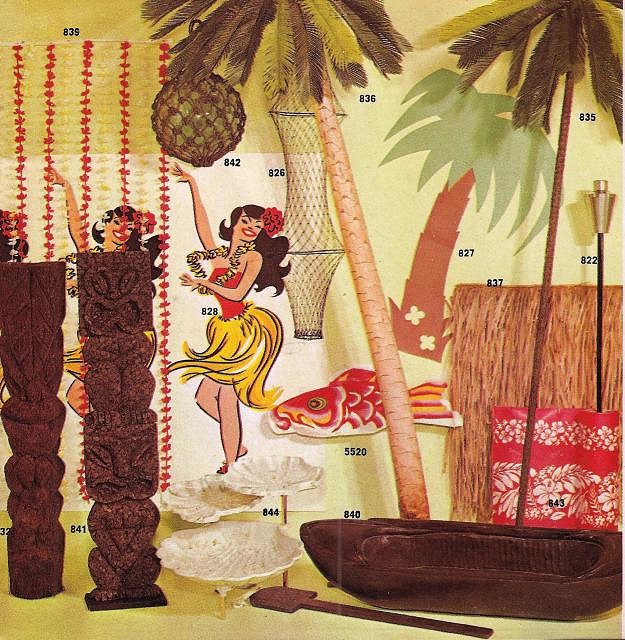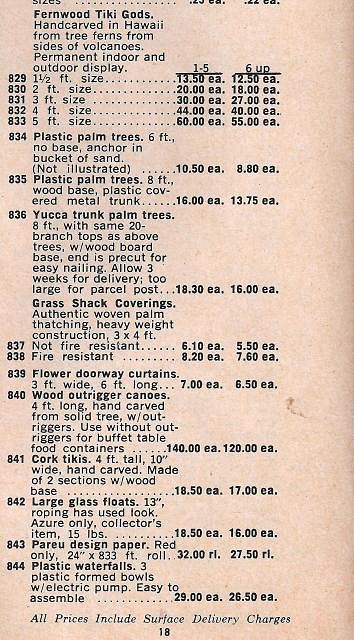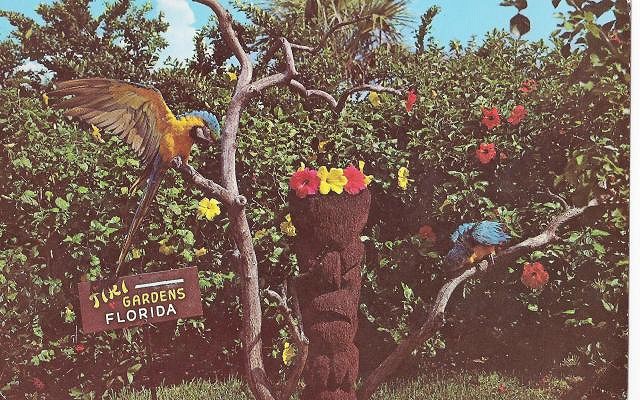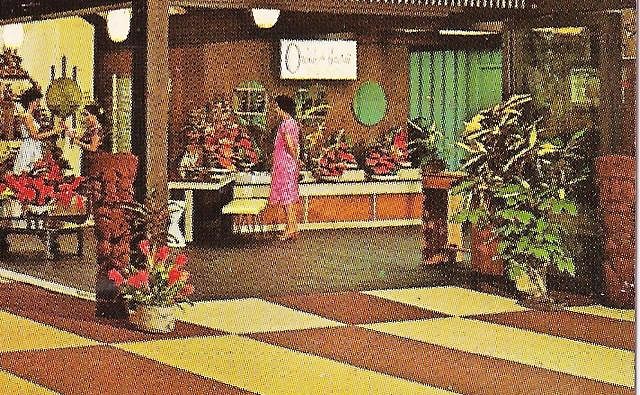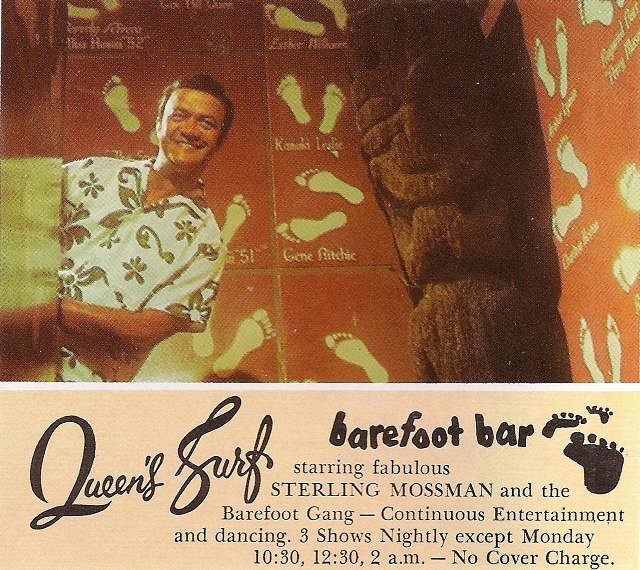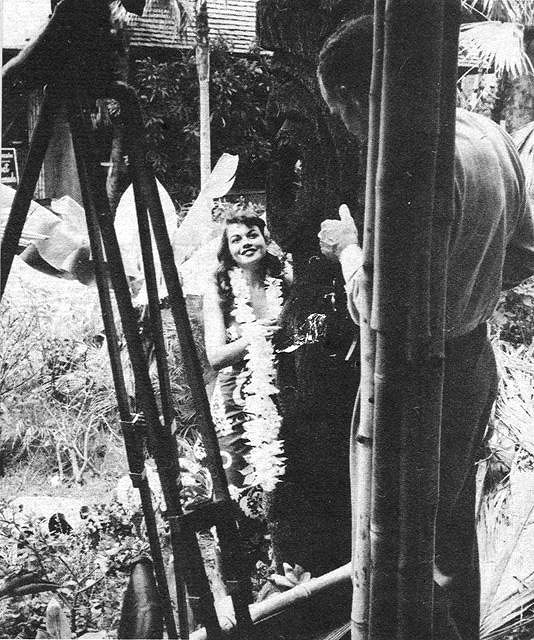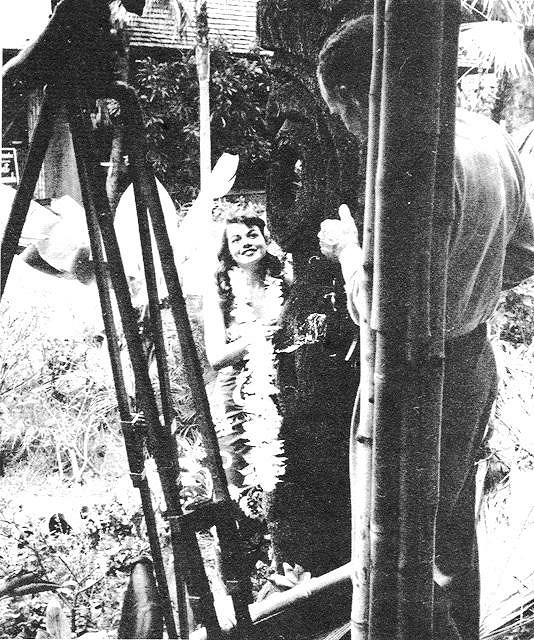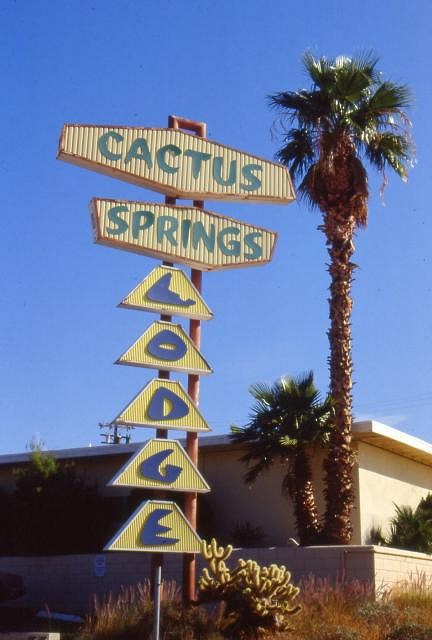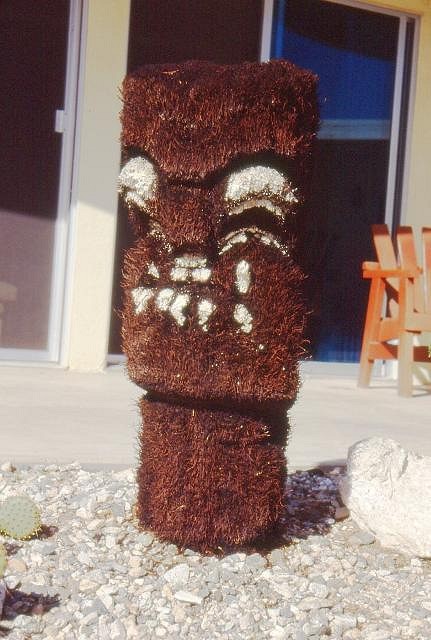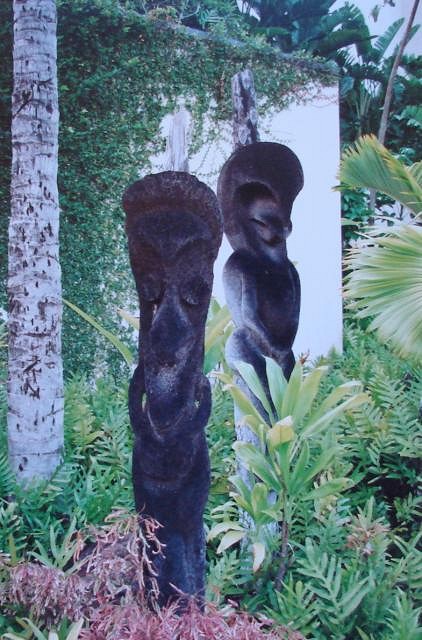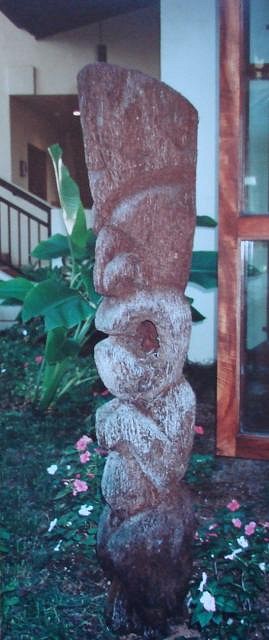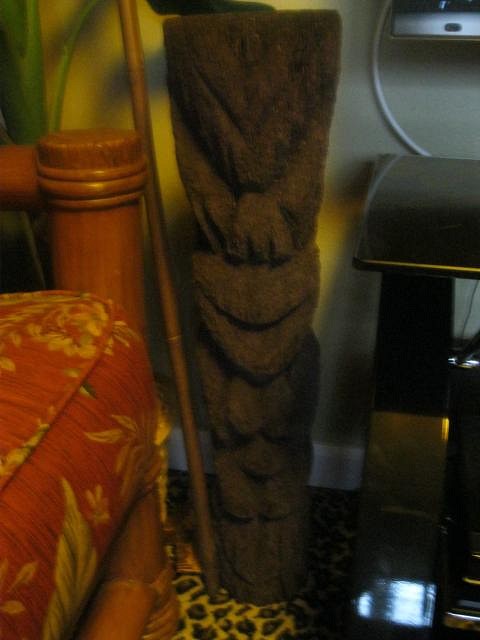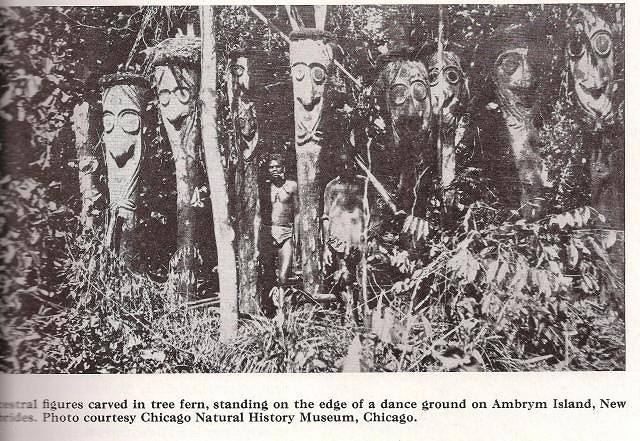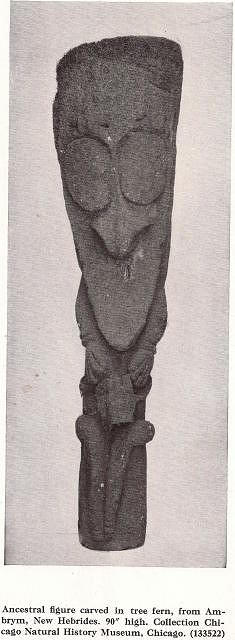Tiki Central / General Tiki
The Mystery of the Hawaiian Fern Wood Tiki
|
STCB

Sabu The Coconut Boy
Posted
posted
on
Wed, Mar 3, 2010 1:22 AM
In "Sippin' Safari", Jeff Berry makes the good case that it was largely Ed Brownlee, working for Donn Beach and Wimberly & Cook who revived the art of carving tikis in Hawaii. Using source material from the Bishop Museum, he begins carving tikis for the hotels in the early 1950s. A 1956 article in the Honolulu Advertiser states "There's a new craze going strong in Waikiki! Or should we say there's been a rebirth of an earlier craze? Whichever you prefer, the man behind the current Waikiki woodcarvings is youthful and handsome Edward Malcom Brownlee." But if you look at enough Hawaiian brochures, postcards, photos, and magazines from the same time period, you'll catch a persistent, repeating image; one that is very disturbing if you know anything about ancient Hawaiian history. Fern-Wood Tikis of high quality are being carved in Hawaii in the mid 50s! Why is this so shocking? First, there is no tradition of Fern Wood carving in Hawaii. All the authoritative texts on ancient Hawaiian sculpture list the various hardwoods used, such as ohi'a-lehua and kauila but not tree-fern wood. No Hawaiian artifact made of fern-wood has ever been found in a burial cave or turned up in a museum. Old texts on native Hawaiian plants from the Bishop Museum list the many uses ancient Hawaiians had for the Tree Fern, including dyes, food, and fiber for embalming bodies, but never carving. Tree Fern Roots were indeed being carved in the South Seas, but only in a few places - way over in Melanesia on Ambrym Island of Vanuatu and in New Zealand. The Grade Society carvings below from Vanuatu were traditionally carved of fern wood and plastered over with mud.
The Hawaiian art of carving temple images (what we now call tikis) had been dead since the 1820s. They had never been done in Fern Wood. Why were Tree Fern tikis suddenly being carved in Hawaii in the early to mid-50s? :down: July 1955 - Honolulu Harry imports a carving of the Goddess "Hina" from Hawaii for his restaurant in Chicago. The high style and quality of the carving seems to indicate an art that's been around for a few years. :down: A Hawaiian travel brochure dated 1955 shows this nice fern-wood tiki. This is probably on the grounds of some hotel. The hut in the background is reminiscent of the Ulu Mau Village, but that wouldn't be built for several years to come. :down: This one shows up at a tourist hotel in Tahiti. The copyright date of the book is 1959, so photo probably taken in 1958, possibly earlier. Style is definitely Hawaiian. :down: The market in fern wood tikis seems to be in full swing by the time this Stewarts' Hawaii Inc. catalog dated 1959 is published. Ed Brownlee might have possibly inspired these tikis, but he wasn't carving them. He was carving hardwood tikis and tikis out of old pilings. Who were these other carvers? And why fern-wood? One explanation might be the orchid craze of the 1940s & 50s. Hawaiian tree ferns were being harvested in large numbers, the fibrous wood being ground-up for orchid-planting media, (sold as "hapu'u" or "osmunda fiber") The orchid craze coincides (and pre-dates by a decade or two) the tourist-carving of fern tikis. Perhaps this ready source of fern-root logs was the cheapest, most accessable media for the tourist carvers to begin working on. Were these first carvers New Zealanders living in Hawaii? Or just local Hawaiians skilled at carving other things like bowls and drums, now being called upon by hotel builders and gardening shops to carve tikis? Or were the first carvers Japanese? The Japanese had been carving their native fern wood for ages. A large block of tree-fern wood would be carved into the rugged shape of a mountain which would provide the perfect medium for growing miniature gardens of bonzai trees and other tiny plants. A newspaper article from 1939 states that fern wood for this purpose could no longer be imported from Japan, so was being imported from Hawaii instead. Did the Japanese-Hawaiians turn their fernwood carving skills into producing tikis?
The harvesting of tree ferns for orchid media eventually threatened all four Hawaiian tree-fern species. They are are protected now, which is why you don't see Hawaiian fern-wood tikis being produced anymore. By the early 1960s, we know for sure that native Hawaiians were carving Fern-Wood tikis. Several gigantic ones were shipped over for the Seattle World's Fair in 1962. They were done by a carver named Kalani.
:down: Here's another at Tiki Gardens in Florida, circa 1964. Another curiosity is that the tree-fern tiki seems to have developed into a style all its own. They look like they were originally based on classic Hawaiian Ku designs, but they also share characteristics that have nothing in common with classic Hawaiian tikis. For instance, many of them have their hands in this puppy-dog-begging pose...
... while original carvings of Hawaiian gods had their hands at their sides or on hips in the classic wrestler's pose. Where did the fern-wood style come from? I hope that some of you will post some of your own pictures of fern-wood tikis (the earlier the better). I'm also anxious to hear your own theories as to how this very-early style of mid-century tiki carving developed in Hawaii.
[ Edited by: Sabu The Coconut Boy 2010-03-06 00:10 ] |
|
BB
Bongo Bungalow
Posted
posted
on
Wed, Mar 3, 2010 3:03 AM
Well done Sabu. Thanks. |
|
S
sirginn
Posted
posted
on
Wed, Mar 3, 2010 7:31 AM
Another great informative and thought provoking thread Sabu. Between this thread and your crypto mugs thread, you are on a roll, thanks for reminding why I stated lurking here years ago. The wealth of info, images, and resources on TC is staggering. |
|
T
TIKIBOSKO
Posted
posted
on
Wed, Mar 3, 2010 10:22 AM
Hey Sabu, great post, I saw your reference to the fern wood carving a couple of weeks ago and wanted to chime in but I was busy, as you can see below I have some opinion about the subject, my post is way too long.
The fern woods are there along with all the other very cheap state side Luau crap, meaning they must have been relatively inexpensive to procure and have shipped to LA. Then as now Hawaii was not a big center for production of Tikis just think about how many places there feature O.A.’s work. I suspect a lot more was being shipped TO Hawaii you wouldn’t believe how many times I’ve heard that a Witco is a hard wood piece bought and carved in “Hawaii”. We (tourists) love more than anything to have this connection to anything “authentically” carved by Hawaiian natives or locals (on the Islands), I’m sure there is a whole psychological explanation for this. There have always been and still are a great may people there just happy support this idea and take your cash, you don’t have to look further than ads on Tiki Central to confirm this. The work is obviously produced in Tonga, Indonesia (you name it) the seller swears (or greatly implies) he masterfully made the work in Hawaii. Most people have no idea what a well carved Tiki should look like and they are all too happy to take this B.S. hook line and sinker, I covered this in last years talk at Oasis (you where there Sabu). This is a pet peeve of mind so let me get back to the subject.
I have a way bigger photo of this carving (it’s so big it looks fake) someplace, I would swear the texture looks to be fern, probably not it’s gigantic, but I know they get pretty big in some parts of the Pacific on the other hand if not what kind of wood is it? All this guys work have a very ridged overly accurate faces that seem to be skwooshed feel to them. These look to be done by the same carver, probably in Hawaii in the mid 50’s, they were obviously show pieces (not usually for a home bar) and they don’t look anything like the small simple ones. On the other hand you can see Kalani who came around a short time later (early 60’s) has a much more of a grasp of form, I love this guys work it is beautiful, but if you also think about it his work looks to have been influenced by the simplicity of the small (late 50’s) fern wood Tikis. Sorry for the size of the next Ulu Mau Village photo he’s are a few more examples of his work, he really took this style to the next level.
Who came up with the mass produced fern designs I have no idea but I can take a guess why the pieces are so bold, it is a crappy material to work in, forms had to be bold because it won’t hold any detail and a few seasons out in the weather will round out any rough shapes making them look even more deliberate. They are quite obviously supposed to be Hawaiian style but when simplified some look amazingly modern others a little clunky. Why fern? It’s an awful material but easy to carve and light weight compared to palm or hard wood. I could go on and on but if you want to read this sometime soon I’ll cut it short, again great job Sabu. My very best Alohas, Bosko |
|
STCB

Sabu The Coconut Boy
Posted
posted
on
Wed, Mar 3, 2010 3:52 PM
Bongo & sirginn - Much appreciated. Thanks. Bosko - Thanks so much for chiming in. I know you've had a strong interest in tree fern tikis for much longer than I have and I hoped you would lend your opinions and expertise. I don't necessarily have any firm belief that those mass-produced fern wood tikis were made in Hawaii. I just kind of fell for the old "if it's in the ad, it must be true" trap. But if they were manufactured cheaply elsewhere and shipped to Hawaii, that would also help explain why the style is culturally similar yet different - like the current Balinese tikis that Trader Vic's sometimes uses with their Buddha-like bellies. That Stewart's ad that I posted uses the word "Hapu'u" for "Tree Fern" which applies to 2 species of fern found only in Hawaii. So if they aren't carved in Hawaii, they would be technically be lying. But again they also could have just wanted a Hawaiian word to describe any generic Tree Fern they might be selling. I've got a different ad from Pally's, from their 1961 yearly Hawaiian Sale, and it proves that they were really mass-producing these guys for cheap:
As far as the Trader Hall's tiki - I'm convinced it's Tree Fern as well. Only fern wood has that dark, rough, fibrous look that doesn't reflect light in photos. If that carver also carved the two 1955 examples in my earlier post, as well as your Ulu Mau examples, then he would seem to be Hawaiian, or at least had access to the Bishop Museum. The classic, crouching wrestler stance from the ancient Hawaiian images is spot-on. The "Hina" tiki looks like it's a mix of a large temple image (knees, feet and head) and one of the smaller Aumakua female carvings (breasts & arms) from the museum's collection. And I love how the Trader Hall tiki takes a large Ku figure and adds a King Kamehameha-style feather headdress on top instead of the standard ladder-like crest or falling braids. If this is indeed the same carver doing these, then he's very creative and talented. But again, this begs the question - why did he decide to use Tree Fern instead of the traditional hardwoods? To your second question - I did some research on the size of the local Hapu'u Hawaiian Tree Ferns (Cibotium spp.) that were used for carving. The trunks can be very tall. One source said up to 8 meters and the other said 25 feet, so they both seem to agree. That would be the carve-able trunk itself. There would be another 6 to 12 feet of fronds attached to the top. The width of the trunk on an old specimen can be 3 feet in diameter. That's plenty big for the large tikis by your carver. It looks like the root also was carved, so that would give the big-head effect that root-ball tikis also have. The back of my "Hina" photo states that she was carved from the root. Someone on TC just posted these snapshots of the Trader Hall tiki and I don't think he's really that huge. It's just the hut he's standing next to is very small:
I think the local Hawaiian Tree Ferns could have accommodated him, as well as the giant World's Fair tikis that Kalani seems to have carved. What do you think? Thanks again for posting on this. Sabu
[ Edited by: Sabu The Coconut Boy 2010-03-03 16:19 ] |
|
J
JONPAUL
Posted
posted
on
Wed, Mar 3, 2010 7:19 PM
&forum&hiliteThank you so much, Sabu! Here are just a few quick reference links to previous fernwood threads and some other visual examples. TNTiki’s post about the Green Garden on Kauai http://www.tikicentral.com/viewtopic.php?topic=6466&forum=2
ZuluMagoo posted some excellent interior postcards of the South Seas, Boston, here... http://www.tikicentral.com/viewtopic.php?topic=11669&forum=1
Tiki Matt brought up a discussion of fernwood Tikis here, unfortunately, all the image links are broken... http://www.tikicentral.com/viewtopic.php?topic=13933&forum=1 Again, another discussion begun by DawnTiki here (with broken links)... http://www.tikicentral.com/viewtopic.php?topic=1486&forum=5 Another discussion by tikiriffic... http://www.tikicentral.com/viewtopic.php?topic=20268=5=bosko%20fern Another discussion by Choptop... http://www.tikicentral.com/viewtopic.php?topic=24431&forum=1 ...featuring the gorgeous fernwood carved by cheekytiki for the Mahiki Here’s a Vanuatu fernwood figure that sold at auction in 2005 for $24,000 Tiki Kiliki has one of the most beautiful fernwood Tikis I’ve ever seen from the Kon-Tiki Ports in Chicago... Matt Reese’s spectacular home bar, the Lava Flow Inn, also has a beautiful fernwood specimen... Here’s a vintage vacation photo from the Ulu Mau Village... A couple of fernwoods in the collection of gtykal... A specimen stated to be from Trader Vic’s in Honolulu... And a 6 foot-plus specimen stated to be from the Dole Hawaiian Pavillion at the '62 world’s fair... Fugu's got a great personal story behind another fernwood specimen in tikiyaki's "Your First/Favorite Tikis" thread...
[ Edited by: JONPAUL 2010-03-03 19:41 ] |
|
LS
Lake Surfer
Posted
posted
on
Wed, Mar 3, 2010 11:32 PM
Threads like this are why I love this website. Thanks for starting this great thread Sabu, and thanks for continuing it with great contributions, Bosko and Jonpaul. Good stuff! I love the Fern Wood tikis. |
|
A
AlohaStation
Posted
posted
on
Thu, Mar 4, 2010 7:47 AM
There are 3 in the entrance to the Mai Kai. Currently they are in very sad shape. |
|
M
Murph
Posted
posted
on
Thu, Mar 4, 2010 10:11 AM
Enjoying this thread! Thanks. |
|
B
bigbrotiki
Posted
posted
on
Thu, Mar 4, 2010 11:21 PM
Indeed, excellence! Shows how there are always untapped facets to Tiki culture yet unexplored. Wish I was with my archive to post some great decrepit fern Tikis. These fibrous beauties dissolved themselves quickly when left to the elements, that's why so few are still around. |
|
H

Hakalugi
Posted
posted
on
Fri, Mar 5, 2010 10:49 AM
Here's another photo of the Trader Hall Fern Wood Tiki. This photo comes from a removable booklet enclosed in the 1960 vinyl lp "Ports of Paradise" by Alfred Newman and Ken Darby. Album Cover: Booklet Page: While I'm at it, here's a Fern Wood Tiki from the International Market Place. This photo comes from the foldout booklet in the vinyl lp "The Magic Islands Revisited" by Axel Stordahl. Album Cover: Booklet Page: Closeup: |
|
G
GatorRob
Posted
posted
on
Fri, Mar 5, 2010 2:20 PM
I don't think I have a picture of them today, but here they are when they were young studs.
Photos courtesy of my all time favorite thread. Hmmmm... that would make an interesting thread in itself: nominate your all-time favorite Tiki Central thread! |
|
K
Kailuageoff
Posted
posted
on
Fri, Mar 5, 2010 5:38 PM
Where do you get those Hawaiian thing-a-ma-jigs? You know, those hula do-dads. [ Edited by: Kailuageoff 2010-03-05 17:40 ] [ Edited by: Kailuageoff 2010-03-05 17:41 ] |
|
B
bigbrotiki
Posted
posted
on
Fri, Mar 5, 2010 10:28 PM
This photo...
...brings up the interesting problem of FERN TIKI FOTOGRAPHY ! Because of these puppies not only being black, but also because of their fibrous, furry texture, they virtually "suck up" the light, and until you had hard sun light hit them in the right angle, their furry features (which also are less defined, more soft, because of the fern wood to begin with), are hard to make out. It pains me to thing that the above is the best photo of these we ever get to see. Because as I mentioned above, they also fall apart much more quickly than their brothers made from palm or other woods. But this only makes them more ethereal and mysterious.. :) |
|
R
RevBambooBen
Posted
posted
on
Mon, Mar 8, 2010 8:35 PM
Here's a picture of my brother at Eli's, Island Trade Store in Midway City, ca. Fernwood Tiki?? late 60's my guess. Great post SABU! |
|
Z
Zeta
Posted
posted
on
Fri, Mar 12, 2010 11:13 AM
Picture taken by yours truly This Tiki is currently in an storage room in Madrid, Spain. |
|
J
JONPAUL
Posted
posted
on
Fri, Mar 12, 2010 11:19 AM
Talk about crazy timing! Marie and I just rescued this guy from an estate sale backyard last week...
|
|
T
TikiG
Posted
posted
on
Fri, Mar 12, 2010 11:54 AM
Nice score JonPaul :) Proof. Treasures are still in the wild (Just curious - found where? OC or LA County? or?) |
|
D
Dustycajun
Posted
posted
on
Fri, Mar 12, 2010 5:20 PM
Zeta, Nice Tiki, where did you find that? Jon Paul, Excellent rescue, are you going to try any restoratoin? DC |
|
Z
Zeta
Posted
posted
on
Tue, Mar 16, 2010 2:07 PM
Dusty, |
|
TT
Tucker's Tikis
Posted
posted
on
Tue, Mar 16, 2010 3:42 PM
This is a thoroughly enjoyable thread. Thanks for all the history. |
|
A
aquarj
Posted
posted
on
Wed, Mar 17, 2010 4:30 PM
Cross-posted from a contribution to a different great Sabu thread.
I wonder what's the story on that tiki, both in date and location, given the photo credit to "Orchids of Hawaii, Inc., N.Y." Speaking of which, as a side note, I don't know if anyone's ever established whether the Orchids of Hawaii company has some relation to actual orchid flowers. That would overlay in an interesting way with Sabu's comments above about the orchid craze stimulating the use of Hawaiian tree ferns. Another, possibly different, OOH...
-Randy |
|
BPB
Bay Park Buzzy
Posted
posted
on
Wed, Mar 17, 2010 4:43 PM
This pile of "vintage Hawaiian seeds" came with this little set of instructions: Buzzy Out! |
|
STCB

Sabu The Coconut Boy
Posted
posted
on
Wed, Mar 17, 2010 4:59 PM
All the brochures and flyers from Orchids of Hawaii (the location in Hawaii) that I've seen indicate it sold orchids only. Don't know how or if it's related to the mug & tiki-decor franchise of the same name in New York. Does anyone know if the OOH of New York also sold Orchids? I haven't seen photos indicating such in bigbro's pictures of their catalog. So yes, very cool that they sold Fern Wood tikis as well as other wood tikis, but these were probably the cheap imports from Hawaii or other Far East sources. It does indicate only a tenuous connection between orchid-growing and fern-wood tiki carving, unless we can establish a connection between the two OOH companies.
[ Edited by: Sabu The Coconut Boy 2010-03-17 17:15 ] |
|
BT
Badd Tiki
Posted
posted
on
Wed, Mar 17, 2010 5:53 PM
Nice subject, some cool tikis I guess Kalani's wood shop teacher never stressed the importance of protective eyewear, or chest, arm, leg ware for that matter :D |
|
OGR

Or Got Rum?
Posted
posted
on
Thu, Mar 18, 2010 5:29 AM
Sabu, This might answer your Orchid question. An Ad from a 1952 New York Guidebook I have. Hope it helps. OGR
[ Edited by: Or Got Rum? 2010-03-18 05:30 ] |
|
C
CheekyGirl
Posted
posted
on
Thu, Mar 18, 2010 1:04 PM
Wow, really fascinating reading. |
|
T
TIKIBOSKO
Posted
posted
on
Thu, Apr 29, 2010 12:40 PM
Hey Sabu I have no idea how you (and so many other people here) get the time to do this as frequently and effectively as you do, when I sit to write a post it takes a day, when I have to back it up with photo reference, forget it, but your research is inspiring. I’ve been digging around thru my reference for something to compare the “paw” hands to, this Massim New Guinea piece is the closest I could come up with but who knows if the fern carver ever saw it?
I was going to make a joke about the plastic rabbit being the basis of the “paws” but then it is from the right time period, so?
“Made in Hawaii” or not, after all these years of Tiki collecting I immediately take all claims, text, legends or history with a huge grain of salt. In junior high school a classmate’s mother wholesaled tourist shop stuff to Hawaii and I still vividly remember how cynical and jaded the girl was about how “all that junk comes from California”. The people that sell/sold any Polynesian pop products were doing just that, selling, the consumer bought not just the product but perhaps more importantly the illusion this thing carried. Today we love Don’s tropical drinks, a certain restaurant, designer, or carver’s creations, (even something crudely executed had the intent) because often these things were great. But in many cases they worked just as hard creating an elaborate mystique or legend that the customers would buy into. Some of the people that wrote LP liner or menu notes (for instance) were amazing, it is like reading exotica porn. ? One of the first vintage articles Sven showed me was the “Backyard Polynesia” article, in BOT pg 250 there is a partial clipping of the story. One of the Tikis was described as being “God of the barbeque” I was floored, it was such obvious BS, but so creative. It really brought home the concept that this was a “mainland” pop phenomenon and clearly someone really must have believed it. Recognizing or appreciating the poetry of it is one thing, but (to me or maybe I’m not reading enough here?) that some of these things were a lie (for lack of a better term) seems to slip under the radar here on TC. It could be when people buy into a “con” they believe it whole heartedly or maybe there is a negative connotation to it and we don’t want to focus on that? Over the years when talking to people that were involved in Tiki (first time around) it never ceases to amaze me what lengths they went to perpetuating “their” legends and how some aspects were a “secret”. Often they’ll try and get one over on me until I tell them I am actually in on it, but that they still continue to use the stories 40/50 years on gives you an idea how deeply embedded they were. Also some originators were very different people than their public persona, which makes the movement even more fascinating. Oddly though there are parallels today (which is a whole other topic) and why or how “educated” Tiki people can’t see the obvious or can justify something absurd is astonishing, but I guess it’s why their naïve grandparents went for it back in the day? If you read the other ads on the Pallys flyer, you’ll see some of what I am talking about, the “Authentic” New Zealand Tiki Masks or the Tahitian God of good Fortune”. It’s all amazing hokum; a detail like where the Fern Tiki actually came from is a minor issue.
Having said all of this it is quite possible that these were carved in Hawaii, the style seems to have a “Western” approach, more than things you saw coming for the Philippines or other parts of the Pacific. Economically it doesn’t seem likely and again I take all these things with a grain of salt. But all it takes is someone posting about a family member being the person who started this giant (fern) carving business in Hawaii and then what did Bosko know? A fact I can actually add to this post; the first fern carving I consciously examined was on the Webley Edwards LP “Hawaii Island of dreams”.
Even way back when I was just starting out it was obvious the caver must have had a tremendous grasp of Tiki carving to do such a “modern” version of a Hawaiian style. I was so inspired that I based my 6th ceramic piece on the style, for some reason people thought I was going for the Frankoma mug but it was in fact that fern Tiki.
My very best alohas, |
|
T
throberts2
Posted
posted
on
Tue, May 11, 2010 5:24 PM
I am looking for a new fern wood tiki and found this site. I can shed some light on the subject, I bought mine in 1961 for a house in hawaii. I think I ordered it from a prison in Hawaii because I was told it was carved by prisoners. It maybe that I ordered it from the old Bamboo Window. Guess I am not going to get a new one. |
|
MR
Matt Reese
Posted
posted
on
Tue, May 11, 2010 7:08 PM
This is truly interesting. Thanks Sabu. The fernwood tiki I own was actually carved by my Aunt's brother in law in the early 60's. I always kind of thought that he just carved what he could find. I didn't realize until years later that fern wood tikis were more common. I'm guessing they were easier to carve than hardwood and possibly lighter for shipping purposes. It may have been a rise in tourism that caused their existence. Mine is in a much more traditional Ku style, I'm guessing that's because it was carved by an American. |
|
Z
Zeta
Posted
posted
on
Tue, May 11, 2010 9:29 PM
I know it's subjective and I am not selling it anyway, but how much do you think this tiki is worth? |
|
B
bigbrotiki
Posted
posted
on
Wed, May 12, 2010 7:02 AM
This Tiki is an example of why such a question is hard to answer. I get asked a lot for advice on the value of Tiki items, and it is always tricky. By the layman, meaning out there in the general market, this guy would be under-appreciated, while to us who know that fern wood Tikis are rarer than wood ones, it might be more precious. But it will probably not be valued as the antique it is. It always depends on who you can sell it two. If two Tikiphiles would get into an e-bay battle over this guy the price could reach, I would say, 3 to 4 hundred ?, but then again if no one bites, it might only go for under a hundred. |
|
G
GatorRob
Posted
posted
on
Wed, May 12, 2010 3:27 PM
I'm curious about this statement: "One can learn a lot about something by knowing it's monetary value." Really? Monetary value is only determined by what someone else is willing to pay for an item. It really doesn't speak to the item's historical or sentimental value, which personally I find a lot more interesting than the item's monetary value. Nice tiki by the way. :) |
|
Z
Zeta
Posted
posted
on
Wed, May 12, 2010 3:39 PM
Gracias GatoRob, |
|
B
bigbrotiki
Posted
posted
on
Wed, May 12, 2010 5:18 PM
Maybe Zeta meant that, when it comes down to it, what is finally put on the table for an item is what the actual market value is, which tells "the truth" about its real worth. In the sense that there can be a much praised and hailed item that gets shown around to lotsa ooohs and aaahs, but that when it is put up for sale and is finally sold, it sorta "underperforms"...or, in rare cases, skyrockets! |
|
Z
Zeta
Posted
posted
on
Wed, May 12, 2010 5:21 PM
Exacto! |
|
Z
Zeta
Posted
posted
on
Wed, May 12, 2010 5:37 PM
Sorry for double posting, but I have to ad to interesting things to consider. Some valid parameter. If you think of all the sentimental and historical reasons why that tiki is valuable is another thing completely. Also, I truly think it's the only one of it's kind that made it's way to Europe. How much would it be to ship it back to Hawaii nowadays? |
|
D
Dustycajun
Posted
posted
on
Wed, Aug 25, 2010 5:31 PM
A few more entries for the fernwood Tiki gallery. I have a copy of the United Airlines Luau Party Planner that has a page selling fernwood Tikis ranging from 1.5 to 5 feet in size (or you could go with the cork Tiki!). This publication sold every kind of Hawaiian chotsky there was, so you know the fernwood tiki was maintream.
A postcard with the fernwood Tiki at Tiki Gardens.
And, the fernwood Tikis at the shops in the Kauai Surf Hotel.
DC |
|
D
Dustycajun
Posted
posted
on
Sun, Aug 29, 2010 12:05 PM
Here is another nice big fernwood specimen from the Barefoot Bar at Queen's Surf in Hawaii.
DC |
|
A
aquarj
Posted
posted
on
Wed, Sep 1, 2010 9:32 PM
Hey DC, that's a great image, and here's another one that must've been taken at the same time. If we play "match-the-feet", the tiki in your pic must be just beyond Charlton Heston's left big toe in this pic. Also note Arthur Lyman's feet cropped off above. Who knew that Arty and Chuck ever went toe to toe!?!
Back to the topic, here's another Waikiki shot that hasn't been on this thread yet, I think. This is on Kalakaua Ave in front of the Princess Kaiulani.
-Randy |
|
STCB

Sabu The Coconut Boy
Posted
posted
on
Tue, Nov 16, 2010 10:41 PM
Found another image of a tiki very similar to this Fern Wood Tiki at the International Marketplace that Hakalugi posted earlier:
Here's a photoshoot taking place in front of what must be a tiki by the same carver. Photography staff provided by the University of Hawaii. This image is from the University of Hawaii's 50-year anniversary yearbook from 1957. No other details.
Same image, with the tiki lightened up a bit:
[ Edited by: Sabu The Coconut Boy 2010-11-16 22:48 ] |
|
B
bigbrotiki
Posted
posted
on
Wed, Nov 24, 2010 8:11 PM
Dug up these slides taken in Desert Hot Springs in November '92 at the Cactus Springs lodge (which later became a hip, renovated resort):
By the pool I found this lonely furry friend...
...a fern Tiki in an advanced stage of decomposition He is a good example WHY vintage fern Tikis are so hard to come by in this day and age: If their fibrous material was decaying even in the dry desert climate, one can imagine what humidity did to them. The ones that seem to have survived best were the ones kept indoors. This place had no other Polynesian touches whatsoever, so the presence of this fella is also an example for how a Tiki was just standard pool decor in California in the 60s, be it in a Polynesian-themed backyard or not. |
|
RH
Robb Hamel
Posted
posted
on
Thu, Nov 25, 2010 3:11 PM
I'd never really noticed this style of tiki before - thanks SABU! What a cool thread. |
|
KV
Kon-Tiki Viking
Posted
posted
on
Thu, Nov 25, 2010 4:03 PM
Thought I'd add these guys to the mix...they're at the Hyatt Regency Hotel at Poipu Beach on the island of Kuaui...at least they were back in 1996 when I took these photos. I think there were over a dozen of them dotted throughout the grounds.
|
|
K
kirby
Posted
posted
on
Mon, Feb 7, 2011 1:51 PM
Here is a pic i recently saw on wikipedia,The tikis appear to be fernwood. [ Edited by: kirby 2011-02-07 13:53 ] |
|
M
McTiki
Posted
posted
on
Mon, Feb 7, 2011 3:50 PM
Those Fern carvings are the bomb! Thank you for sharing! |
|
D
dogbytes
Posted
posted
on
Mon, Feb 7, 2011 4:50 PM
i got this for $53 dollars at a mall!
|
|
D
Dustycajun
Posted
posted
on
Wed, Feb 16, 2011 6:00 PM
That picture of the fernwood Tiki troop posted by Kirby is great, look at them all. I just got a copy of the Arts of the South Seas book ($5 on Amazon) and was perusing it. Noticed these photos of original tree fern tikis that were carved in the New Hebrides islands of Melanesia.
DC |

